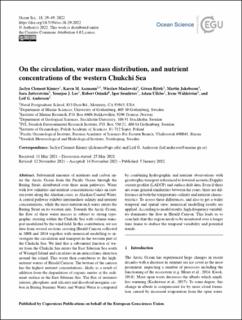| dc.description.abstract | Substantial amounts of nutrients and carbon enter the Arctic Ocean from the Pacific Ocean through the Bering Strait, distributed over three main pathways. Water with low salinities and nutrient concentrations takes an eastern route along the Alaskan coast, as Alaskan Coastal Water. A central pathway exhibits intermediate salinity and nutrient concentrations, while the most nutrient-rich water enters the Bering Strait on its western side. Towards the Arctic Ocean, the flow of these water masses is subject to strong topographic steering within the Chukchi Sea with volume transport modulated by the wind field. In this contribution, we use data from several sections crossing Herald Canyon collected in 2008 and 2014 together with numerical modelling to investigate the circulation and transport in the western part of the Chukchi Sea. We find that a substantial fraction of water from the Chukchi Sea enters the East Siberian Sea south of Wrangel Island and circulates in an anticyclonic direction around the island. This water then contributes to the high-nutrient waters of Herald Canyon. The bottom of the canyon has the highest nutrient concentrations, likely as a result of addition from the degradation of organic matter at the sediment surface in the East Siberian Sea. The flux of nutrients (nitrate, phosphate, and silicate) and dissolved inorganic carbon in Bering Summer Water and Winter Water is computed by combining hydrographic and nutrient observations with geostrophic transport referenced to lowered acoustic Doppler current profiler (LADCP) and surface drift data. Even if there are some general similarities between the years, there are differences in both the temperature–salinity and nutrient characteristics. To assess these differences, and also to get a wider temporal and spatial view, numerical modelling results are applied. According to model results, high-frequency variability dominates the flow in Herald Canyon. This leads us to conclude that this region needs to be monitored over a longer time frame to deduce the temporal variability and potential trends. | en_US |
